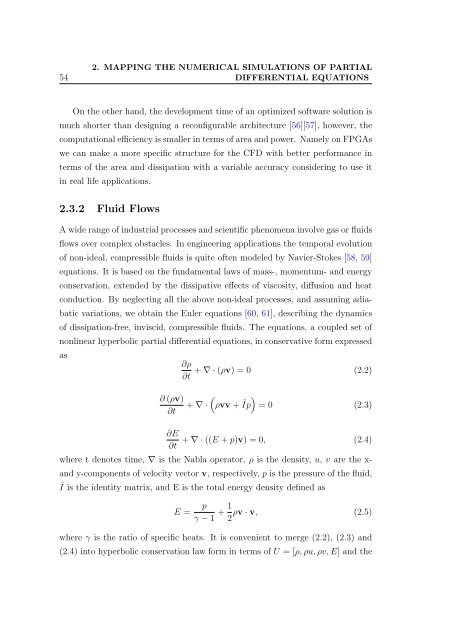PPKE ITK PhD and MPhil Thesis Classes
PPKE ITK PhD and MPhil Thesis Classes
PPKE ITK PhD and MPhil Thesis Classes
You also want an ePaper? Increase the reach of your titles
YUMPU automatically turns print PDFs into web optimized ePapers that Google loves.
54<br />
2. MAPPING THE NUMERICAL SIMULATIONS OF PARTIAL<br />
DIFFERENTIAL EQUATIONS<br />
On the other h<strong>and</strong>, the development time of an optimized software solution is<br />
much shorter than designing a reconfigurable architecture [56][57], however, the<br />
computational efficiency is smaller in terms of area <strong>and</strong> power. Namely on FPGAs<br />
we can make a more specific structure for the CFD with better performance in<br />
terms of the area <strong>and</strong> dissipation with a variable accuracy considering to use it<br />
in real life applications.<br />
2.3.2 Fluid Flows<br />
A wide range of industrial processes <strong>and</strong> scientific phenomena involve gas or fluids<br />
flows over complex obstacles. In engineering applications the temporal evolution<br />
of non-ideal, compressible fluids is quite often modeled by Navier-Stokes [58, 59]<br />
equations. It is based on the fundamental laws of mass-, momentum- <strong>and</strong> energy<br />
conservation, extended by the dissipative effects of viscosity, diffusion <strong>and</strong> heat<br />
conduction. By neglecting all the above non-ideal processes, <strong>and</strong> assuming adiabatic<br />
variations, we obtain the Euler equations [60, 61], describing the dynamics<br />
of dissipation-free, inviscid, compressible fluids. The equations, a coupled set of<br />
nonlinear hyperbolic partial differential equations, in conservative form expressed<br />
as<br />
∂ (ρv)<br />
∂t<br />
∂E<br />
∂t<br />
∂ρ<br />
∂t<br />
+ ∇ · (ρv) = 0 (2.2)<br />
)<br />
+ ∇ ·<br />
(ρvv + Îp = 0 (2.3)<br />
+ ∇ · ((E + p)v) = 0, (2.4)<br />
where t denotes time, ∇ is the Nabla operator, ρ is the density, u, v are the x-<br />
<strong>and</strong> y-components of velocity vector v, respectively, p is the pressure of the fluid,<br />
Î is the identity matrix, <strong>and</strong> E is the total energy density defined as<br />
E =<br />
p<br />
γ − 1 + 1 ρv · v, (2.5)<br />
2<br />
where γ is the ratio of specific heats. It is convenient to merge (2.2), (2.3) <strong>and</strong><br />
(2.4) into hyperbolic conservation law form in terms of U = [ρ, ρu, ρv, E] <strong>and</strong> the






![optika tervezés [Kompatibilitási mód] - Ez itt...](https://img.yumpu.com/45881475/1/190x146/optika-tervezacs-kompatibilitasi-mad-ez-itt.jpg?quality=85)









